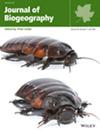Recent Long-Distance-Dispersal Explains the Range Disjunction of the Old-Word Cockleburs (Xanthium strumarium)
Abstract
Aim
In the present study, we focused in addressing questions concerning the biogeographic history of Xanthium strumarium, an Old World native species whose close relatives are generally all native to the American continent.
Location
The species distribution covers the Eurasian continent and some African regions and close islands.
Methods
We employed herbarium material and target enrichment (herbariomics) sequence data of over 700 single copy loci to estimate the divergence times of the species. Ancestral range reconstruction was employed to test different hypotheses on the events that determined the arrival, differentiation and dispersal of the ancestor of X. strumarium in the Old World.
Results
The crown age of X. strumarium was estimated to be ~156.58 ka. In the phylogenomic analysis, the individuals from the different geographic areas grouped mostly congruently based on their collection origin, the earliest diverging clade comprising samples from India, and then progressively clades including samples from Asia, Europe and Africa. The same pattern was observed in the biogeographic analysis, with a movement of the ancestral ranges going from east to west. The ancestral range of the species was inferred to be the Indian subcontinent.
Main Conclusions
Both the use of herbarium specimens as old as 240 years and the use of modern sequencing techniques clarified the phylogenetic relationships, divergence time and biogeography of Xanthium strumarium. Most probably, the ancestor of the species reached the Old World by way of a trans-Pacific long-distance dispersal from the Americas to Southeastern Asia, followed by westward colonisation of the Old World.


 求助内容:
求助内容: 应助结果提醒方式:
应助结果提醒方式:


